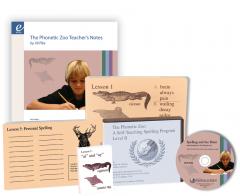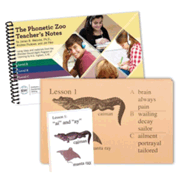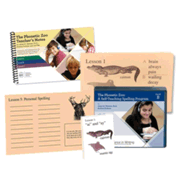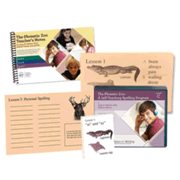The Phonetic Zoo, also called Excellence in Spelling, is an unusual spelling program targeted at children ages 9 and up. It is offered at three levels of difficulty, with the third level geared for students at least sixth grade, but more likely high school level. An introductory video presentation demonstrates how the program works. It is possible to figure out how to use the program from the eight-page booklet that comes with it, but the video clarifies and demonstrates exactly how it works.
The same set of flashcards is used with all three levels. There are 47 lessons/flashcards in the set.
These half-page size flashcards feature pictures and names of animals on the front that exemplify particular spelling rules or hints for each lesson. On the back is the rule, a jingle, or hint to be learned. There are also three lists of words, arranged by levels A, B, and C. Children only work with those words that are on their level. Every fifth flashcard is used for personal spelling words that are collected from other spelling challenges a child encounters during the week. Parents can introduce each flashcard and work with children, especially introducing each new lesson. Or children can work with the flashcards independently.
Instead of a workbook, children work with words by listening and writing. Five CD's for each level direct the child in independent study through most of each lesson. Rules, jingles, and hints are presented. (This might be a repeat of a parental presentation, but that's not a problem.) Students are encouraged to study the words on the flashcards before beginning to listen to the lesson on the CD. On the CD each of the fifteen words is pronounced and used in a sentence. Children prepare a piece of paper upon which they will write the words as they hear them. After all fifteen words have been presented, children check their own work by listening to correct spelling on the CD.
One technique I don't see explained in the directions, but which is demonstrated on the video, is to have children write the correct spellings as they listen to them on the CD in the process of correcting their own papers. I would have a child ONLY write the words from the pronounced spelling (next to each word they wrote on the first time through the lesson that day) and not try to check words at this point. After they have written all of the words, they should compare their original and the correct spelling. A child might not SEE his misspelling until the correctly spelled word is written next to it. Students repeat each lesson, writing the words each time, continuing until they are able to score 100% two times in a row with the same list.
Children should use headphones to help them concentrate on the auditory input and to keep them from being distracted. The CD presentation also frees parents from lesson preparation and presentation while still providing children with the focused input they need.
This program should be especially good for children who are strong auditory learners. The idea is that as children listen to the words being spelled to them, writing as they listen, the sequential order of the letters is reinforced in the brain. The authors do not claim this is the best program for every child, and they offer a money-back guarantee if it does not work for your child.
The independent nature of this program might work very well for some children. (Parents should check from time to time to ensure honesty.) This removes some of the embarrassment children experience in other programs. It also allows children to go through each lesson as many times as they need with no stigma. If they score 100% the first two times, they can complete a lesson in only two days.
The selection of words seems to have been determined by the need to use words as exemplars of rules. Thus these are not the most commonly used words but an eclectic mix. For example, lesson 26 includes the following words for level A: "true, bluebird, avenue, have, value," and "due"; level B includes "groove, eave, mauve, tissue, flue," and "cue"; level C has "continue, queue, subdue, valve, dissolve," and "starve." Canadians will appreciate alternative spellings in parentheses such as "neighbor (neighbour)."
For high school students, you might want to check out Advanced Spelling & Vocabulary that uses a similar approach.
You might want to check out the premade lesson plans from Homeschool Planet that are available for The Phonetic Zoo.
Find lesson plans available for this product at Homeschool Planet. Sign up for a 30-day FREE trial.













